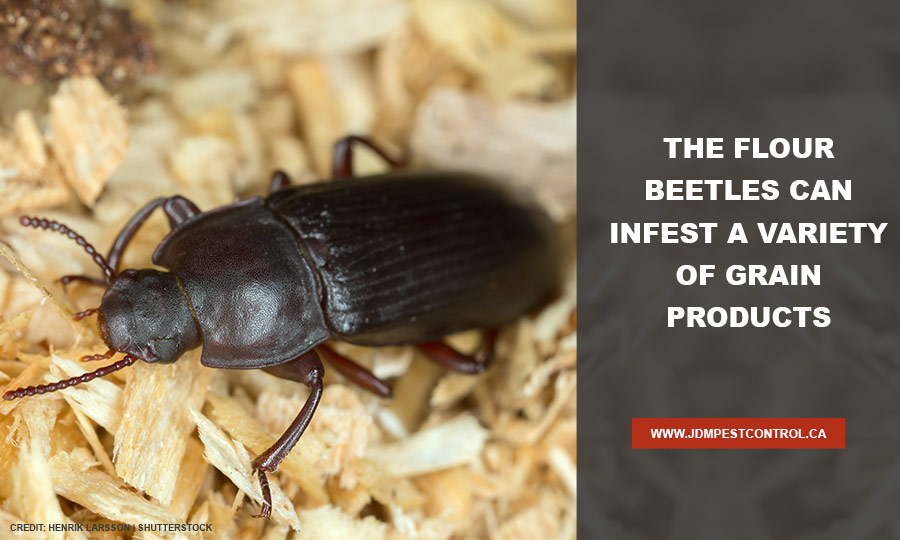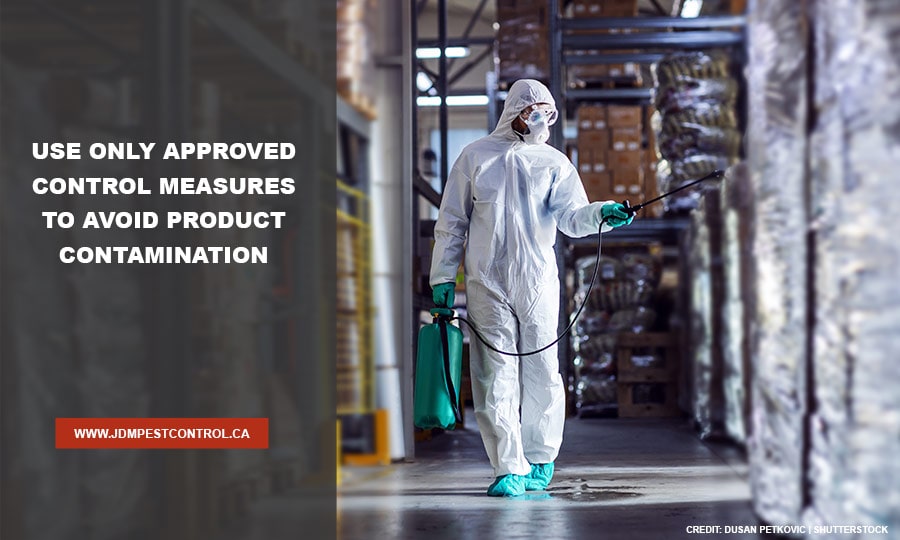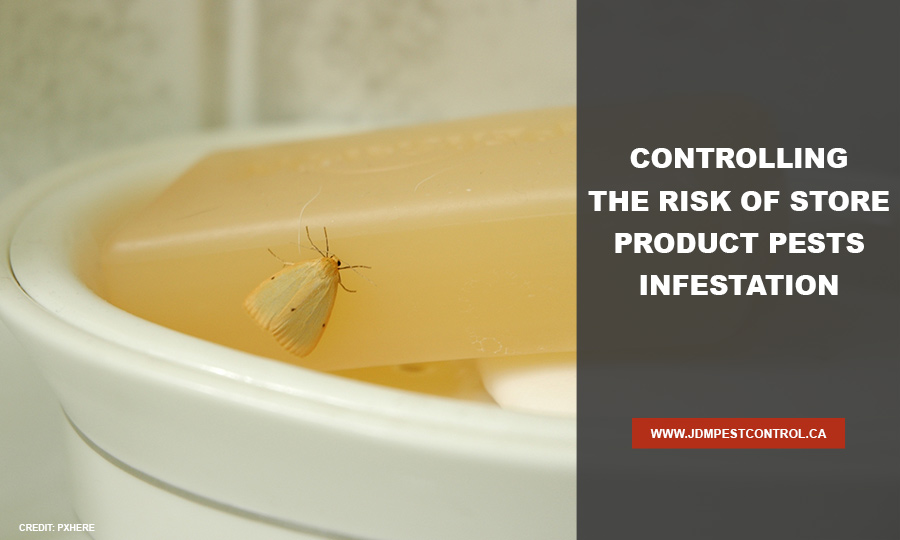You may be digging through your pantry for baking goods when you notice small insects running across your sack of flour. You could be wondering where they came from, especially if you like keeping your space nice and tidy. What might surprise you is that these insects may have gone home with you straight from the store.
They can sneak into items stored in paper bags and unsealed packaging. Because of their disingenuous behaviour, it is often challenging to detect them until their population has exploded.
What Are Stored Product Pests?
Stored product pests is a collective term for insects, mostly beetles, and moths, that infest food and certain non-food products. You may find them in different stages of development — egg, larva, pupa, and adult. If the food source is abundant, their population can increase exponentially, their infestation becoming widespread and sustained.
These pests vary widely in food preferences. Food products, such as cereals, flour, cookies, herbs, spice, dried fruits, and vegetables, nuts, and seeds, are among the most common. In non-food products, they can be found in potpourri, cigars and tobacco, bean bags, jewellery, decorative walls, and table arrangements.
Stored product pests often infest products that have been opened. However, they can also infiltrate unopened packaging, like thin cardboards, plastics, foil, and cellophane. They can chew their way in or crawl through the folds and seams.
Types of Stored Product Pests
There is a wide range of stored product insects worldwide including:
- Beetles

- Sawtoothed Grain Beetles
Sawtoothed grain beetles are named after their saw-like teeth. They are only 1/10-inch long with a slender and flattened body and brownish-red to almost black colour. Their larvae are cream-coloured and about 1/8-inch long.
They are commonly found in dried fruit, cereals, nuts, dried meat, macaroni, and seeds.
- Flour Beetles
Flour beetles, as the name suggests, are found mainly among flour products, but they can also infest bran, cereals, dried fruits, nuts, and chocolate. There are two types of flour beetles: the red flour beetle, which is common in homes, and the confused flour beetle found in flour mills
They are 3/16 inches in size, reddish-brown, and oval-shaped. The larvae are whitish or cream, 1/4-inch long, and have 2 pointed spines on the tail end.
- Warehouse Beetles
The warehouse beetle is oval-shaped, 1/8 to 3/16-inch long, and has a dark and light mottled pattern on its wing covers. The lifespan of this beetle is relatively short, but they are excellent fliers, which means they can spread easily. They also have the ability to diapause or remain inactive when the food becomes scarce, making it very difficult to control them. - Drugstore Beetles
Drugstore beetles are about 1/8-inch long, oval, and brown. They also appear humped due to their head bent down. Similar to warehouse beetles, they are fairly short-lived but good fliers. They are attracted to light, so they are often found away from sources of infestation and near windows and lights.
Drugstore beetles fed on spices, dried flowers, tobacco products, and paper products, including cardboard and books.
- Weevils

- Rice, Granary, and Maize Weevils
This type of weevils is slender and reddish-brown. They can be identified by a long snout projecting forward from the head. Their larvae require a food source with a hard or semi-hard coating, like corn kernels, beans, nuts, or rice. Adult female weevils lay their eggs inside these whole kernel grains. Adult weevils can live for 3 to 6 months. They can even “play dead” when disturbed. - Bean Weevils
Bean weevils are a type of seed beetle. They are broadly oval-shaped and about 1/8-inch long. They have short wing covers and have a mottled light and dark brown colour. Unlike other weevils, they don’t have a conspicuous snout. Their larvae are legless and C-shaped. They also feed inside dried beans and peas. - Indianmeal Moths
Indianmeal moths are the most common variety of moth infesting stored products. They have a wingspan of 1/2 to 5/8 inches. Their wings are pale grey or tan at the base, while the rest is reddish-brown and coppery. Their larvae are white with shades of yellow, pink, green, or brown. Only the larvae feed in stored products. Larvae normally leave the food once they have matured.
Foods infested by Indianmeal moths will contain a silk webbing on the surface of the product.
Signs of Stored Product Pests Infestation

The most obvious warning sign of a stored product pest infestation is almost always the presence of adult insects – moths flying around or beetles running across the cupboards.
Many may think that getting rid of them may solve the problem, but the other stages of an insect’s life cycle (egg, larval, and pupal) aren’t always easy to spot and could very well be present and alive in your store products.
Other signs include:
- Visible holes and damage – Check the packaging and the products themselves. Stored product pests and insects usually burrow their way into the items, leaving these signs of entry.
- Silk webbing – Moth larvae leave these webs as they feed and move through the product.
- Suspicious stains – Discolouration on the product is a warning. Infected grains also tend to get warmer, which can cause dampness, mould, and even grain germination.
- Track marks – Insects scuttling around the area can leave their tracks in the dust or flour.
- Frass or excrement of insect larvae – Insect droppings are also a dead giveaway that you’re dealing with an infestation.
-
How to Control the Risk of Stored Product Pests Infestation?
Stored product pests pose a serious risk to humans and establishments alike. They can damage raw materials and ingredients, deeming them unusable to make new products. It also presents a threat to food businesses as well, such as food processors, warehouses, and retailers. Pests in the food handling industry can cost them not only revenue but their license and permit to operate as well. Other affected sectors include the hospitality and textile industries.
Here are some tips to manage stored product pests:
- Invest in Prevention

The first and foremost line of defence is to deny them access to your premises. Your place must adhere to the highest standards of hygiene and sanitation. Clean up all spills, dust, and other messes from your property, machinery, equipment, storage, and vehicles.
Stock your products inside the robust and airtight packaging to keep insects out. All items must be placed above floor level for easy cleaning and inspections. If possible, install insect screens and screen doors.
- Shop Smart and Be Vigilant
Especially with the pandemic, more people rely on door-to-door deliveries, but recent studies suggest that this can attract pests. It is important that you remain vigilant with your shopped items and groceries. Inspect each item for any signs of damage before placing them into the cabinet.
You can also use lures and traps to capture these insects. Besides, it is recommended that constant monitoring and cleaning be made. Remember to check the expiration dates while you’re at it and toss out old products that have been stored for a long time.
- Use Approved and Effective Control Methods

If you think that the situation requires treatment, make sure that you use only approved and effective control methods to avoid product contamination. Some methods used to remove stored product pests are dusting, precision spraying, and fumigation. Be sure to contact a pest specialist to avoid further damage.
While these insects may not be as common as other pests, such as rodents, cockroaches, or ants, stored product pests can still cause a variety of problems. It takes utmost caution and care to manage the risk of infestation.
Treat infestations fast! With over 20 years of experience in the industry, JDM Pest Control is more than capable of exterminating pests and protecting homes and commercial establishments. Dial (416) 729-3568 for a free estimate of our services now.
